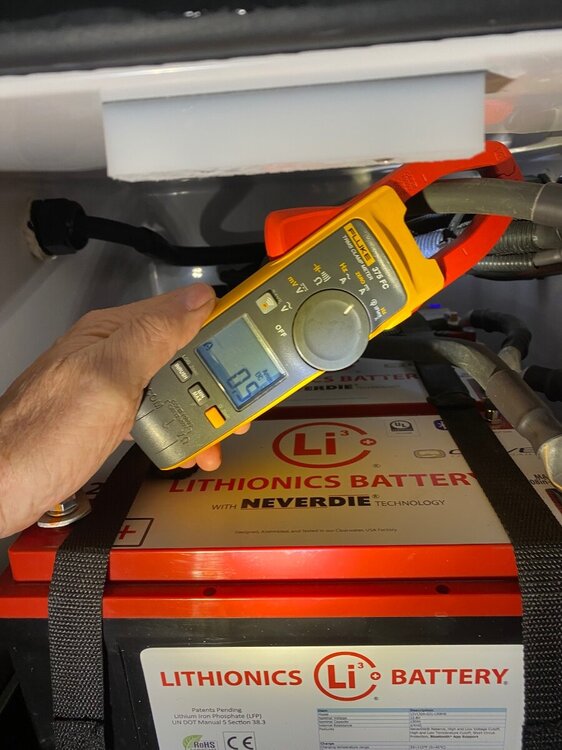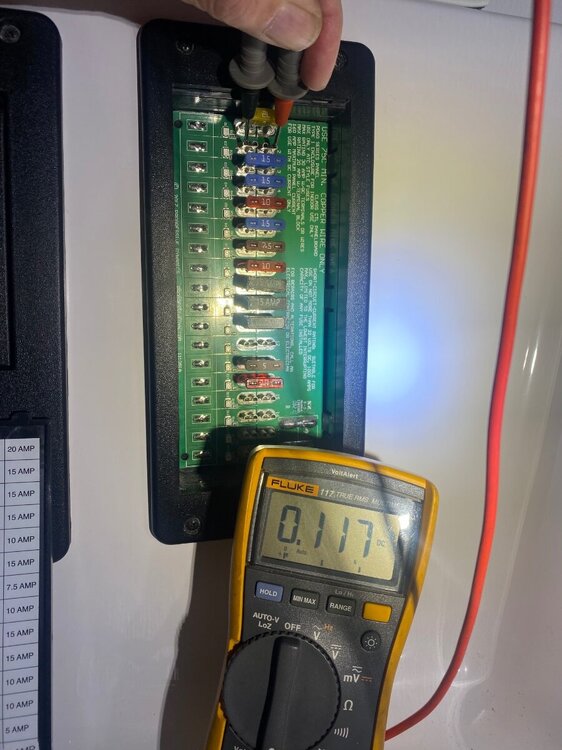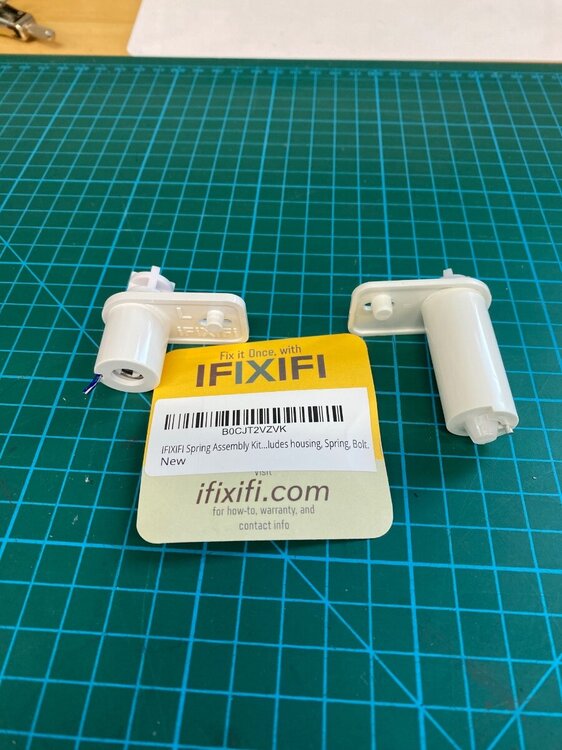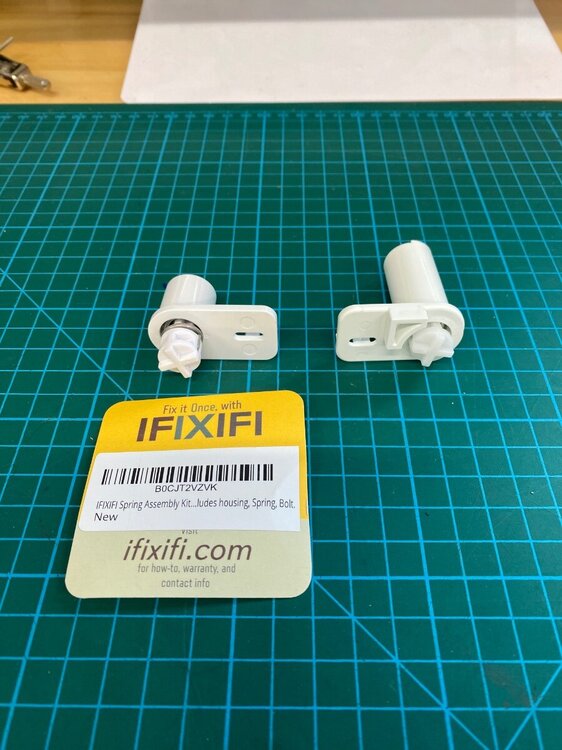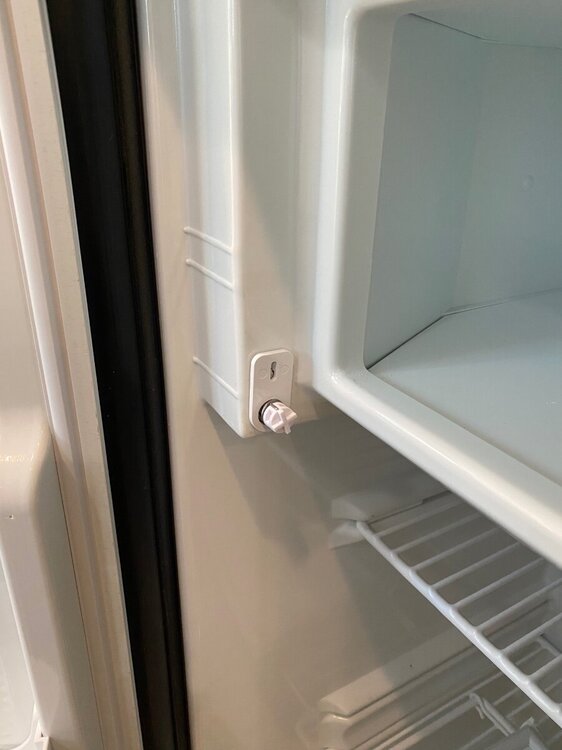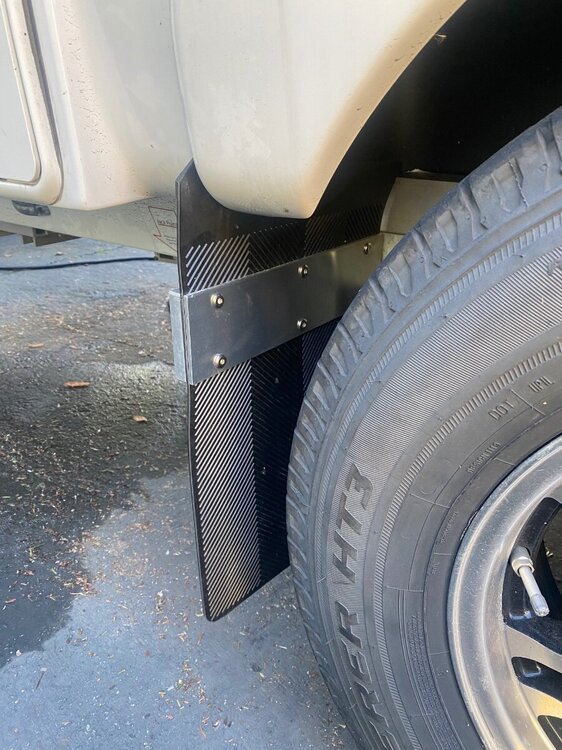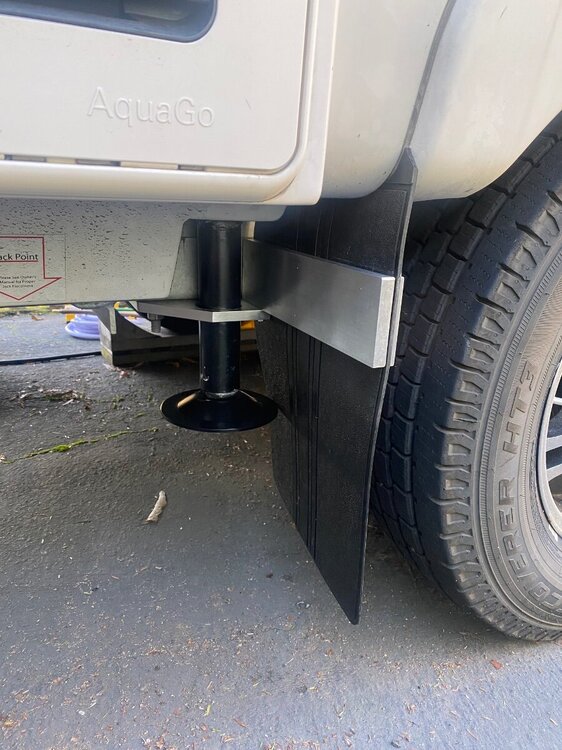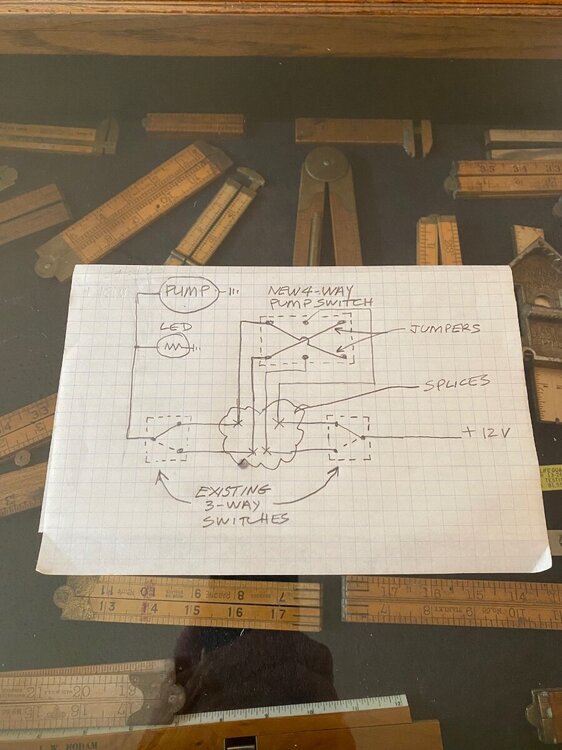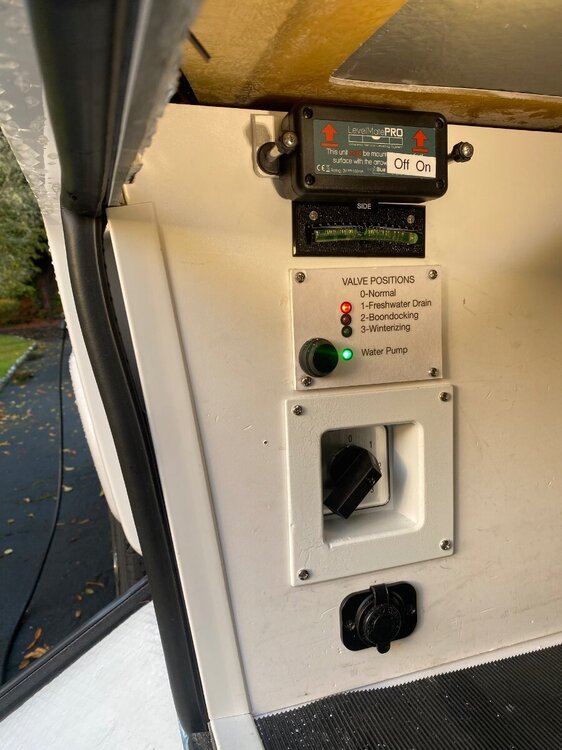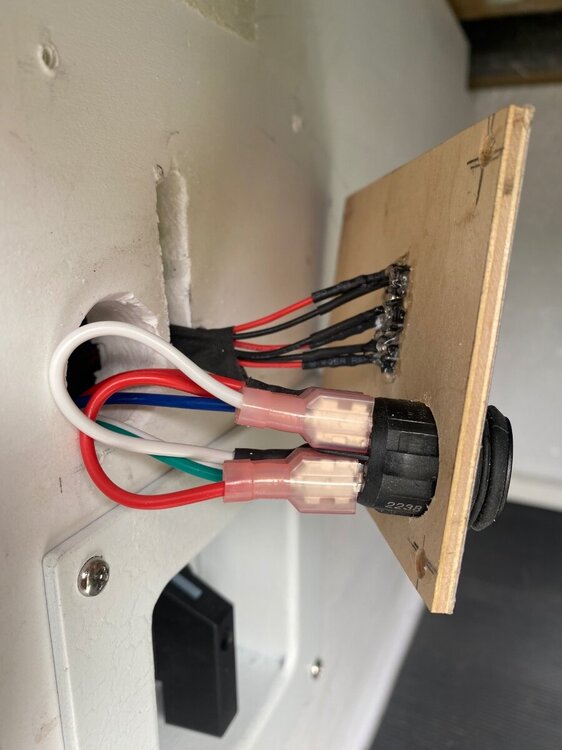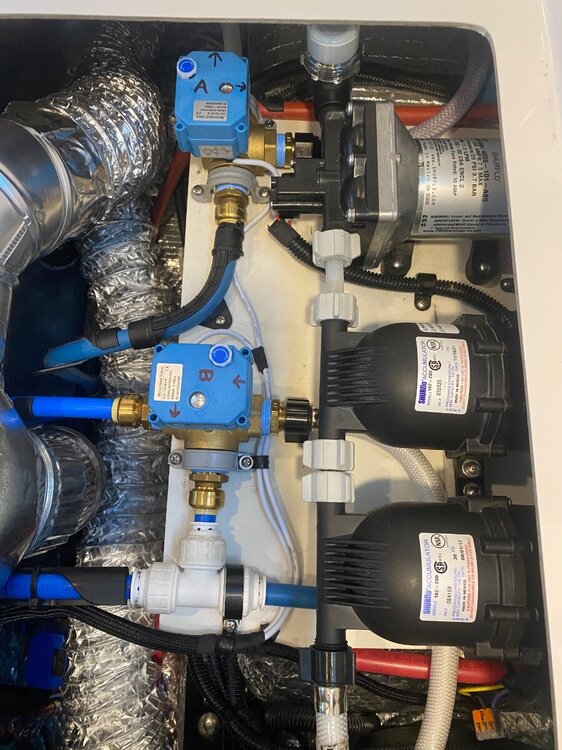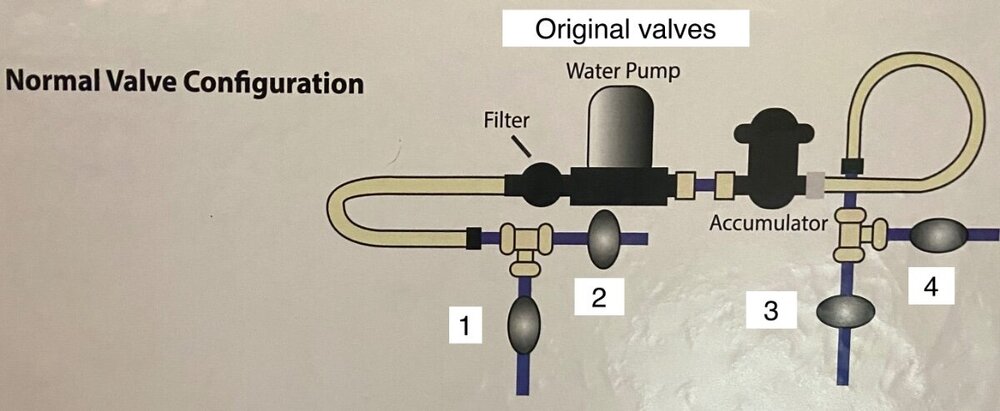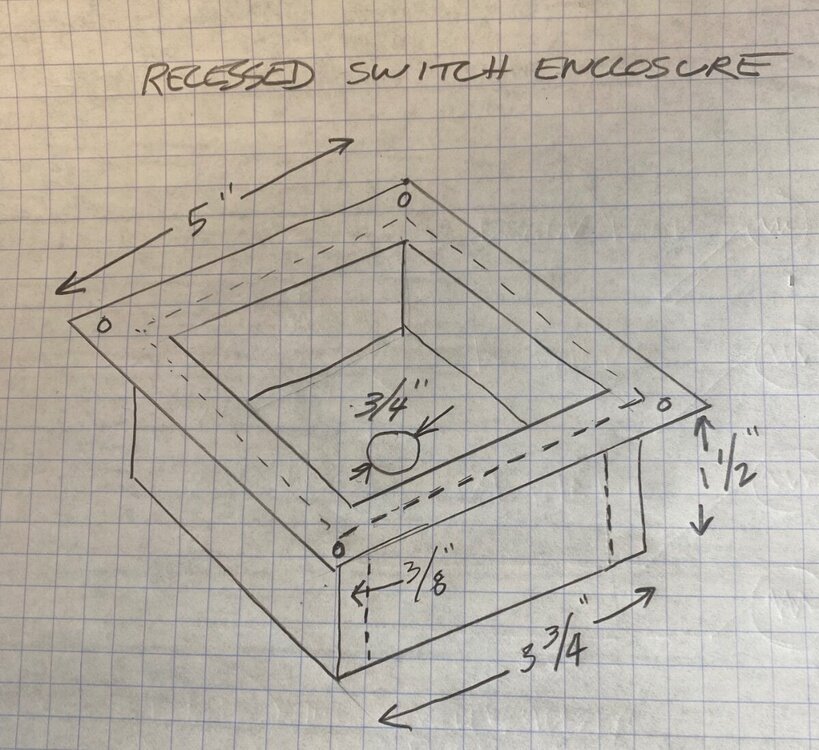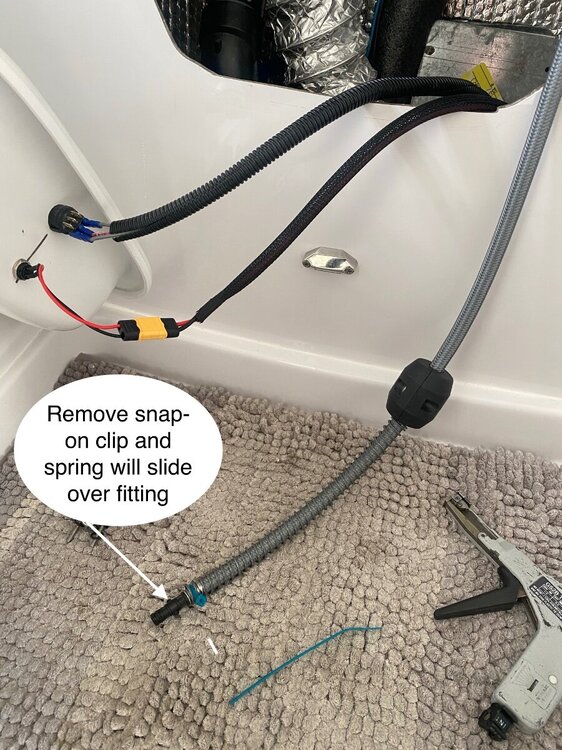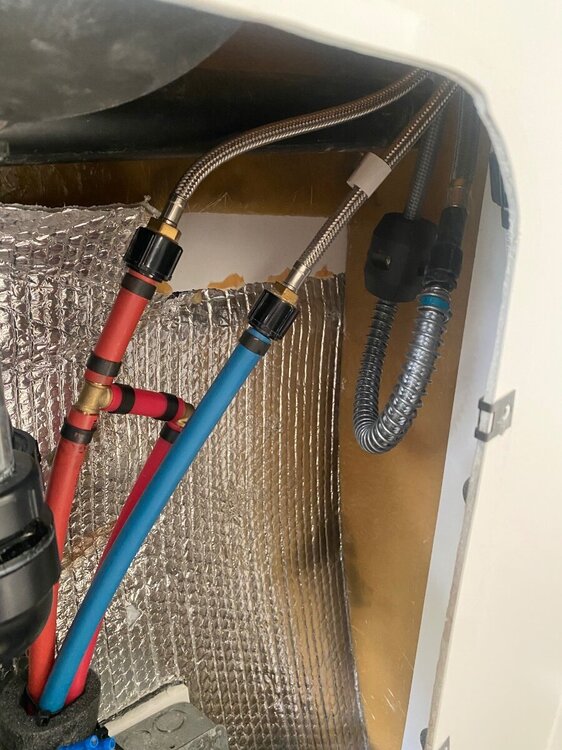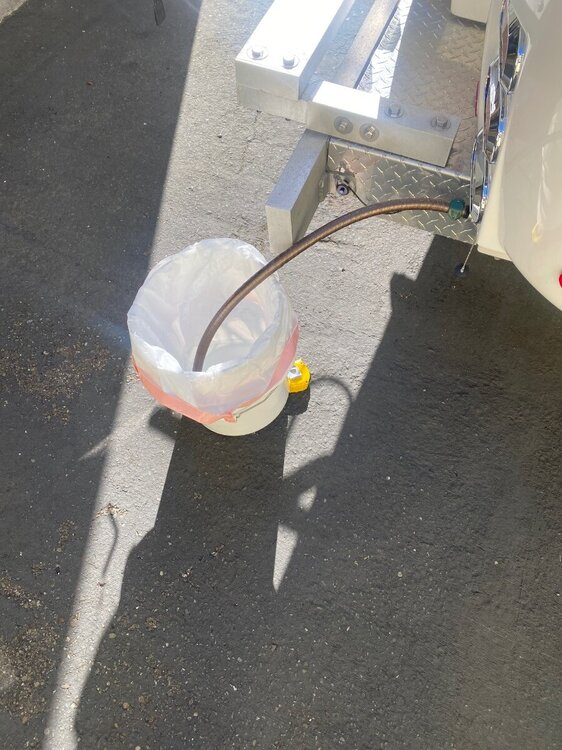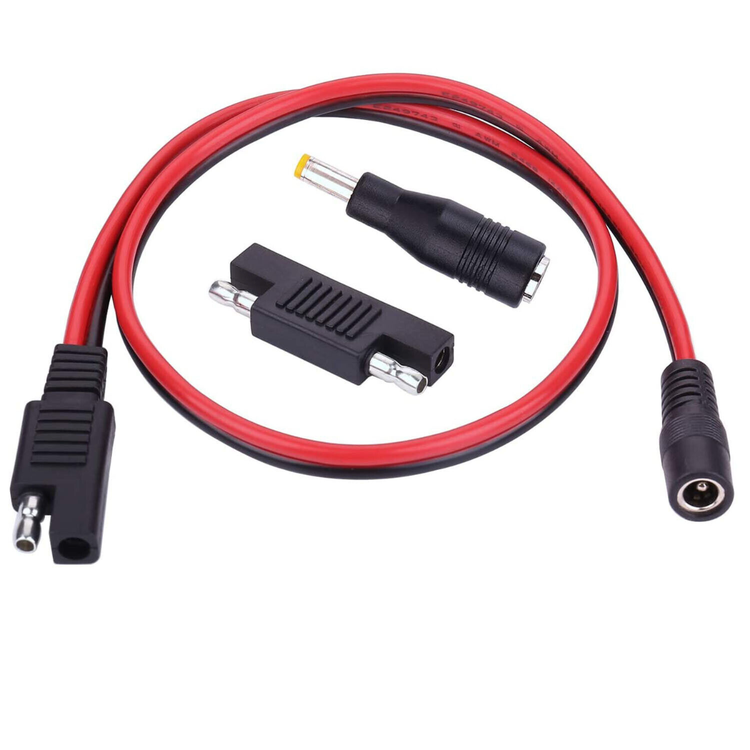
Snackchaser
Members-
Posts
196 -
Joined
-
Last visited
-
Days Won
11
Everything posted by Snackchaser
-
I decided to chime in on this because I don’t think you’re missing anything, your discharge rate is perfectly correct! All the given advice is good, but it’ can be a bit miss-leading to fully understand whats going on. I hope to provide a better explanation, and show you a simple and very accurate way to check your “parasite” loads, which I’ll refer to as normal “stand-by” loads. Your 390 amp hour battery with a daily discharge rate of 3% equates to a loss of 11.7 amp hours over a 24 hour period. This further equates to a stand-by load of 0.48 amps, which is not overly excessive considering all the electronic devices in the Oliver. Devices with memories, remotes, touch lights, rain sensors, USB ports, electronic boards, etc., can each draw milliamp currents even when turned off, and they do add up quickly. I took some current readings from my own trailer to show you what I mean. It’s the same year as yours and it also has a 390 amp hour battery. Remarkably, the values add up to exactly the same current as your calculated load. But more importantly, it shows that there is no single extraordinary load: Fuse 2, Various electronics = 0.117 amps Fuse 4, Furnace = 0.012 amps Fuse 5, Main lighting = .003 amps Fuse 6, Fans = 0.016 amps Fuse 7, Water heater = 0.113 amps Fuse 8, Radio = .204 amps Fuse 9, USB outlets = 0.007 amps Fuse 10, USB outlets = 0.009 amps Total = 0.481 amps These measurements were done with a precision multimeter having a resolution of 3 decimal points. My Victron shunt has a resolution of 2 decimal points and it showed a lessor current of 0.42 amps. My Clamp-on Amp Meter has a resolution of 1 decimal point, and it showed a higher current of 0.5 amps. This demonstrates how subjective and inaccurate some of these measurement methods can be when dealing with such small milliamp values. Another potential misconception is that the Lithionics BMS App will provide the overall charge and discharge values. It’s only true to the extent that it provides values for the battery selected, but not for each battery combined. For example; the 390 amp hour package consists of three 130 amp hour batteries. If the overall load is 3 amps, then the App will show each battery discharging at 1 amp. Additionally, it’s only accurate to 0 decimal points so it won’t show anything less than 1 amp. This is another good justification for installing a Shunt. There are a number of ways to measure stand-by or parasite current, but the easiest and most accurate way is with an inexpensive Multimeter through the fuse box. It will show the load of each circuit, but not each component on the circuit. Thats okay because some of the individual component loads are too small to be accurately measured anyway. Caution: When using the ammeter function, the meter is in-line with the circuit. This means that the current is running through the leads and meter. So don’t use it with loads greater than it’s rated maximum current, which is typically 10 amps. Before testing, make sure that everything is off including the inverter/charger and solar (Solar switch is in the street side overhead cabinet.) Make sure shore power is unplugged too. Pull each fuse one at a time and the red LED “blown fuse” indicator will light-up if there is any load. Put your ammeter leads on each leg of the fuse socket and read the current. Add up the values and you will have an accurate overall stand-by load. FYI, the inverter/charger does not go through the fuse box, but it will add another 0.2 amps load if left on. I keep my trailer undercover without shore power and the batteries also discharge rather quickly. In fact the shunt screen shot below shows that it will discharge in 10 days. I considered adding a battery master switch, but it wasn’t a viable option for a number of reasons which is why I believe that Oliver doesn't install them either. I ended up getting an auxiliary solar panel, with charge controller, and I mounted it on the roof to keep the batteries at 100%. It was better than running an extension cord and risking complete discharge mishaps. Hope this helps Cheers, Geoff
- 66 replies
-
- 12
-

-

-

-
Norcold Fridge Hinge Parts - Availability Issue?
Snackchaser replied to DunnYet's topic in Mechanical & Technical Tips
Hurray! Dometic freezer hinges work in the Norcold! Although I repaired my old broken Norcold hinges, I had also ordered a replacement right-hand hinge while they were still available. It was then I noticed that Dometic freezer hinges looked very similar. The major dimensions were the same, only the spring barrel was shorter, so I ordered a left one from a family owned Oregon company called iFiXiFi, and it works perfectly. It's so nice to have that door snap firmly closed again! There are actually several aftermarket Dometic hinges on Amazon, but the iFiXiFi brand seemed better and they also have Youtube videos that cover the design and quality of their parts and installation methods. It was about $35 for the Left hinge including the shorter spring and hinge pin. You may notice from the photos that the Dometic style hinge does not have the "90 degree open stop" as does the Norcold. This is to prevent the main door from bending the freezer door past 90 degrees to the point where it could break. The Dometic refrigerators have stops moulded into the frame for this purpose. You can retain this feature by using a Norcold right hinge, which are still available, with the Dometic left hinge. Otherwise just be mindful of it. Amazon https://a.co/d/fftOAMe IFiXiFi installation videos: https://youtu.be/fXQCQgKwjGo?si=ES5rrbr0vK1UJB2N I also recommend this video, it was the method I used. https://youtu.be/8Ae0ncOSu9U?si=wBuMTqLK6erE5Jqi I should mention that AliExpress also carries a Dometic hinge kit that comes with the left and right hinges including springs and pins for $29, but I can’t vouch for the quality. Cheers! Geoff -
I just finished this great mod! Thanks Minnesota Oil! FYI, this modification can be done with hand tools, it just takes a lot of elbow grease with a hacksaw. I used a woodworking bandsaw with a fine blade and 2" hole-saw." The edges were draw-filed for a polished look. I didn't mill out a recess to fit the frame per Minnesota's plans, but I did drill and bottom tap blind holes (not all the way through) for the mud flaps. All the aluminum was available at Amazon: 12" x 8" x 1/2" plate 12" x 3" x 1/2" bar 12" x 3" x 1/8" bar I had some difficulty finding decent mud flaps. I ended up getting a set at O'Reilly's Auto Parts, they had a chevron patten on one side and vertical lines on the other. Cheers! Geoff
-
When doing a modification to install an outdoor valve control switch (Electric valve control… with a twist,) I realized that an outdoor pump switch would also be nice when doing valve operations. Not only that, but the pump switch is handy for the outside shower too! To understand this modification, it helps to know about 3-way and 4-way switches. The two existing pump switches are common “3-way” switches like you would find in a hallway to turn the light on from either end. To add a third switch to the circuit, then you need a “4-way” switch, but they are less common and not readily available in RV style switches. Fortunately though, the more common Double Pole Double Throw (DPDT) - On/On switch can be modified to make a 4-way switch just by adding two jumpers. This modification requires removal of the cubby/shelve under the bathroom vanity, and it’s a good opportunity to do the “Bathroom Vanity Cubby Modification“ by Frank C, it makes access to this area a whole lot easier. With the cubby removed, locate and cut the two grey wires going to the bathroom pump switch, these are the “travelers” that go to the main pump switch. Splice four new wires to the cut grey wires and route them under the dinette to the new switch. I used a rubber booted DPDT switch and mounted it in the outdoor storage area on the front facing wall. It snap-fits into a 3/4” hole. The new wires were protected by split sheathing. I also added an optional LED indication light for the new 4-Way switch, which is powered from the pump’s +12v whenever the pump is energized. Amazon LEDs are ridiculously inexpensive and easily mounted in a 3/16” hole. I hope someone finds this useful. Cheers! Geoff Shopping list: DPDT On/On switch No KDH3BNA1BBB (From Digi-Key company) 3/8” split wire sheath Optional 12 Volt 5mm LED Light with LED bezel Holder
-
- 4
-

-

-
Norcold Fridge Hinge Parts - Availability Issue?
Snackchaser replied to DunnYet's topic in Mechanical & Technical Tips
Oh boy, another one bites the dust! Those little notched pins for the freezer door hinge broke off on ours too, and now the door won’t stay closed or seal. I searched the net for new parts and nobody had the left spring holder assembly. But while searching, this post popped up and I found out Im not alone! Apparently Norcold is out of business and these parts are no longer available. So short of replacing the whole fridge, I figured out a way to repair them. I cut out pieces from 1” x 1/16” brass bar to “sister” onto the broken spring holder assemblies. Holes were drilled for a 3/16” brass pin and 1/16” rivets. I filed notch’s on the brass rod to match the original pins and soldered them into place with plumbers flux and solder. I trimmed the excess, and filed it flat. The new brass piece was riveted onto the hinge with 1/16” diameter x 1/4” flat head brass rivets. Fortunately I had all the brass and rivets in my stash, but most hardware stores carry this stuff. It was a little tricky to install the hinges with enough spring preload, probably because the repaired hinges were stiffer and wider than the originals. Here’s what worked for me: Put the repaired right spring holder assembly in it’s final position on the fridge wall. Remove the right door mount clip from the door. Install the left spring holder assembly onto the door mount clip so it has spring pre-load. Mount left side door with spring holder/clip assembly onto fridge while maintaining spring pre-load. While holding door in place, use left door clip to wind some pre-load and screw it on the door. Hope this saves someone a new fridge! Cheers, Geoff -
This modification improves electric valve control by adding a rotary switch to select the four different valve line-ups: Normal, Freshwater Drain, Boondocking, and Winterization. I was really inspired by JD1923 and C&M Currie who replaced their quarter-turn valves with electric valves so they didn’t have to lift the bed mattress to change valve positions. This is a fairly extensive modification because the heater vents had to be removed for access to the valves, the new electric valves had to be installed, a recessed enclosure was needed to protect the switch, and number of new wires had to be run Four of the original quarter-turn valves were replaced with two 3-way electric ball valves in the orientation shown in the photo. I used 3/4” valves with 1/2” adapters and SharkTooth PEX fittings for better flow. A little heat helped to slightly bend the PEX pipe into position, and the valves were clamped down with 1” electrical PVC clamps. A 1/2” electric ball valve was used for the freshwater tank drain. There was limited room to work in this area so it helped to pull out the PEX drain pipe where it penetrates the floor. The switch was mounted on the forward facing wall of the outdoor garage where it’s more convenient to conduct the valve operations. To keep it out of harms way, I made a recessed mounting plate out of 1/8” hobby plywood and moulding stock as shown on the drawing. The plywood can be cut with a razor knife if needed. The following legend helps explain how the rotary switch is configured. It shows the original five quarter-turn valves and the replacement motor operated valves. It also shows the four switch positions as they correlate to the valve line-ups, and the wire terminals used per the wiring diagram. Original Oliver Valves 1 2 3 4 Drain New Valve Identification Switch Position Switch Terminals Valve Line-up A (3-way valve) B (3-way valve) Drain 0 None Normal* Open Closed Closed Open Closed 1 1-2 3-4** Freshwater Drain Open Closed Closed Open Open 2 5-6** 7-8*** Boondocking Closed Open Open Closed Closed 3 9-10 11-12** Winterizing Closed Open Closed Open Closed * Valves in the de-energized position ** Terminals used for optional LED indicators *** Terminal-8 is Jumpered to Terminal-10 The rotary switch needs jumper wires that can be pre-wired on the bench using ring terminals. This will keep them in place while connecting the field wiring using the included forked terminals. The valves use very little current so the +12Vdc can be picked from any convenient power source and protected with a 5 amp fuse, I used a nearby breaker. An internal capacitor powers the valves back to the “Normal “ position when de-energized (Position-0.) Five wires were encased in 3/8” split sheathing and routed under the floor to the valves. This included three power wires for the valves, one ground wire daisy-chained to each valve, and one spare wire for an optional pump LED that I’ll cover in a different post. I also added an optional 1/8” plywood label board with LEDs to indicate which valve line-up is selected. I printed out a switch label, had it laminated, and glued it on piece of 1/8” plywood with holes drilled for the LED’s. This was a fun project and just as I finished, I had a big surprise! 😃 Another Oliver owner, Taylor.Coyote, just happened to drive by. 😃 It was great to meet Chris and I look forward to meeting again. Cheers! Geoff Shopping list: 2 - U.S. Solid 3/4” 3-Way Motorized Ball Valve #USS-MSV10004-G 1- U.S. Solid 1/2” Motorized Ball Valve #USS-MSV00007 4 - 3/4” NPT male - 1/2” PEX fittings 2 - 3/4” NPT male - 1/2” NPT adapters Four position, 12 terminal (6 contact) rotary switch Taiss #LW26-32 0-3/3 3/8” split wire sheathing Misc. PEX fittings Optional PEX crimp cutting tool Optional PEX crimping tool Optional - Amazon 12 Volt 5mm LED Lights with mounting bases
- 1 reply
-
- 10
-

-

-

-
Last year while messing around under the bathroom sink, I adjusted the weight on the “pull-down” faucet hose so that it would pull out far enough to rinse the toilet. That worked for awhile, then the hose started kinking when it was pulled all the way out. Rats! So while preparing for the next trip, I decided to try another approach. I found a 1/2” x 10” spring at the local Ace that fits snuggly over the hose (when little snap-on clip is removed.) The spring was tie-wrapped in place and it allows the hose to bend tightly without kinks. Now the hose easily reaches the toilet for better rinsing. This is a quick and easy mod, particularly if you have done the “Bathroom Vanity Cubby Modification” by Frank C. It allows cubby to be quickly removed without having to re-caulk every time. I was also adding a little water freshener today, so thought I’d share another idea that's probably not new. We always carry a 5 gallon bucket and tall kitchen bags to use as an outdoor trash can. If we want to fill the fresh water tank from the Boondocking inlet, we use the bucket with a new trash bag as a clean liner. We also carry a short piece of garden house for this purpose. Saved us a few times. Cheers! Geoff
-
Oh boy! Your’e going to get some different opinions here. But it’s Saul Goodman 😃. I think your’e drawing is right. . . that's if you are going to use a polarized breaker. However, a polarized breaker may not be the best choice between the charger and battery. Here is my logic: The breaker mainly protects the wire in this application, so you want it close to the power source. In your case, you have two power sources, the battery and the charger. The battery has much greater current potential so it should have priority. Additionally, any short circuit condition will trip the charger’s AC input breaker, but the battery will cook the wire if not properly protected. Sometimes this is not intuitive, and charger breakers are installed backwards, or at the wrong end of the circuit. That’s why I’d prefer to use a fuse between the charger and battery, because it protects the wire in both directions and it doesn’t care how far it’s from the power source. In other applications, such as you’re 40 amp + busbar feed, breakers are great. But be mindful of how the solar charger is tapped in, so that the smaller gauge wire is properly protected from the battery too. Consider a fuse or non-polarity breaker if you can find one. I love this forum, some great discussions. I wish you guys were my neighbors.
-
There are some good comments so far. It was interesting to learn that some solar panels were not meeting their rated capacity, and the sun doesn’t always cooperate either. This is a positive for the DC to DC charger because they have a more reliable output. It was also good to hear that others run their ac off the DC to DC charger, this is a strong selling point IMO. Yes I was disappointed when the 50 amp Victron charger came out after I installed the 30 amp, it’s way improved in efficiency, thus reduced heat. I'm surprised that OTT is not using it. On the bright side, the 30 amp uses smaller gauge wire, but I think a cooling fan is still needed because it starts derating at 104 degrees. This could be less than ambient air temperature when you'd want to run the ac, and you could run down the battery faster if the charger output is not 100%. From what I've seen with the 50 amp specs, this should't be an issue. This raises another important point that trailer folks should be aware of. Most of the DC to DC chargers are used in camper-vans and boats with short wire runs to the alternator, and the multitude of videos and wire specifications reflect that. However, trailer installations have much longer wire runs, typically around 50 feet one way, so they will require larger wire to minimize voltage drop. Even the Victron 50 amp is sized for maximum #4 wire, which would be too small for most trailer applications. Alternator capacity was not something I've given much thought to, because mine was something over 200 amps. It’s good idea to check your'e alternator rating by looking up the alternator code or use an on-line VIN decoder. I believe most newer trucks are at least a 100 amps or more. TV voltage errors should’t be a concern because Victron has safeguards to shut down in low voltage conditions, and they are designed to work with smart alternators that are constantly adjusting output for better fuel economy. Cheers! Geoff
-
Solved! I did some more extensive probing and found the elusive street side porch wire. This thread was pretty long so I decided to start a new one for how to add a second porch light switch, please see the new post titled “How to add a second switch for the street side porch lights. . . finally” Thanks Mossey for that photo of the porch ground wire. I love the collective wisdom and ideas in this forum, and that picture it’s what started me on the right path! Cheers! Geoff
-
This modification was a break-out from an old and long thread that Mossemi started: “Only one switch to operate streetwise and curbside lights . . .” It concerned a common complaint that the curb side porch lights can’t always be used because the street side lights also come on and they can annoy the neighbors. Mossey posted a new photo of the main switch panel wiring yesterday, and it showed a ground wire labeled “porch light”.” I hadn’t noticed it before, so I tried my circuit signal probe again and finally found where the circuit crosses over to feed the street side porch lights. It was in a sheathed wire bundle behind the attic side board, deep along the right bottom corner. It can’t be reached through the attic without disturbing the insulation, but it can be reached through the right rear speaker hole. The duct tape dust cover will have to cut open then re-taped afterwards. The wire bundle has enough slack to splice it though the speaker hole. I pulled the positive “red” wire out of the “split-sheath” wrap and verified it was the right one with a clamp-on amp meter. It read something like 0.9 amps with the lights on. I cut the wire, capped the end coming from the old switch, and spliced a new blue wire to the lights end. A Wago connector was easier than trying to crimp a butt splice in the tight space. The new wire was sheathed for extra protection and routed to the main switch panel. It was tie-wrapped to an existing wire bundle on the forward edge of the attic ceiling. With the left attic side board also removed (they are held by two small lag bolts), the wire can be passed into the left side upper cabinet. A short stiff wire will help fish it through. The upper cabinets have thin laminate floors fastened with a few Phillips screws. Remove them to expose a channel that the new wire can lay in all the way to the main switch panel. I also removed the microwave outlet for more room to feed the wire into the switch panel area; just snap off the cover plate, loosen the two mounting screws slightly so the wings fold in, and it will come right out. I had a round rocker switch in my stash, and they are also available from Amazon. I installed it in the blanked hole for the “Street Awning” switch, and blacked out the word Awning with a felt marker. The switch just says “Street” now, for the street porch light. Very unprofessional, but I hope someone will had a better solution. If you don’t have a blanked spare switch hole, then a switch can be mounted on the other side of the switch panel, on the inside cabinet wall. The switch was wired with the new blue wire going to the middle terminal, the red hot +12Vdc to the bottom, and the yellow ground to the top (needed for the blue neon indicator.) The other ends of the hot and ground wires went to existing six-port push-in terminals that feed other switches. There were some unused ports. This is easier than it sounds, but it’s good to have a clamp-on amp meter and/or circuit tracer to help find the street porch light wire. I included a photo and list of the tools I used. The inexpensive brands work well enough, and I’d recommend owning them for other electrical projects, troubleshooting and repair work: Digital clamp-on ac/dc amp meter, also a multimeter, can check your shunts and loads too! Circuit tracer for finding wires, shorts, and breaks Metal fish tape, I cut short pieces off the end for these kind of jobs Cable tie gun, you will wonder how you ever got by without one Auto wire stripper, just makes it easier Thomas and Betts crimpers, 50 years old and still my favorite go-to Inspection mirror Fluke multimeter, when accuracy counts Cheers, Geoff
- 4 replies
-
- 10
-

-

-

-
Mossey, Your thoughts are correct, up to the point about a junction in the load side of the switch. The load side wire from the porch switch disappears into the wall behind the switch panel in a tightly tangled mass of wires and junctions that are stuffed into a space too small. Without disturbing the wires too much, I’ve probed with an inspection mirror and I’m certain there is no junction or splice on that wire. It probably runs through the gap between the outer and inner walls to the nearest porch light by the door, then daisy chains to the other lights from there. At some point the wires need to cross over to the street side. I hoped to find it within a wire bundle in the attic or basement. But they also could have run it through the gap between the ceiling and roof where they ran the wiring for the ceiling lights, they even stuffed the crimped splices into that gap. The ground wire must take the same path in the opposite direction, originating from the ground bus. There are also wire bundles that run along the bottom back of the shelves, it could be there. But I’m not crazy about breaking into them without better intelligence. Anyway, I guess we're still no further ahead on the wiring side of the problem. Geoff
-
That's a great idea! I'm going to look into the lamin-x, but not the z-bar just yet. I can't cut the wires as suggested either. There's no way to reach them without removing the fixture, and I'm not confident the fixture can be removed without damage. My experience with one of the puc lights is that it was short wired with no slack for a splice. Had to solder extension wires to very short stubs, very sketchy. I'm afraid these lights are the same way. It turned out to be easy to check the ground wires with a clamp-on amp meter, and I quickly found the ground for the porch lights. Unfortunately all four lights were on the same loop so no luck with that idea. They are nice lights, just wish they could be switched off at times. So I'm still hoping someone will find the correct wire.
-
Thanks, that's a handy chart! You really have to be careful using on-line calculators because some specify "one-way," and others leave you guessing. You can see by their wiring diagram that a one-way measurement may not be accurate, and just 5 feet can make a difference.
-
No, most electrical is under the dinette except the master switch panel by the door. There is a lot of wire passing through the attic though, and Iv'e checked a lot of them with a clamp-on amp meter looking for those lights. At this point I'm convinced the wire is routed around the front through the bathroom area where it would be much harder to isolate. That electrical drawing shows it in the front too. Geoff
-
I agree with everyone that this is most likely a battery problem. The flucuating voltage confirms it, and when you are plugged into shore power everything was working fine from the charger/converter. Corroded terminals could defiantly cause the problems you described. With any sign of corrosion, all the connections should be cleaned and wire brushed because some of the oxidation can't be seen and it will cause high resistance connections. Hopefully that solves the problem, but keep in mind that the batteries could be so deeply discharged that it may take a while to bring them back. If that does't work, then you could have a battery with an internal short when under load. This is common and a voltage test may not see it. You might have to disconnect each battery and load test them individually. Harbor Freight carries cheap load testers, but battery shops usually have better ones. Only after that would I be looking in other places for the problem. Cheers and good luck! Geoff
-
Oliver Simplified Electrical Schematic
Snackchaser replied to Patrick1962's topic in General Discussion
Patrick, Nicely done! I've already printed it up for the Oliver file. After a recent close call, I'm trying to better document all the crazy mods I've done for the next guy. This drawing will help in that regard, to sketch-in the changes. Thanks, Geoff -
I don’t like to open old sores, but I was wondering if anyone ever figured out how to fix this continuing annoyance? I’ve done some poking around at different times trying to find the wires that feed those street side porch lights. The curb side switch-leg wire is behind the main switch panel, but Iv’e never been able determine where it splits off to feed the street side. I even tried a signal tracer with no luck. I once had an idea to install magnetic reed switches inside the light fixtures to turn them off with a magnet from the outside. I painfully took one of the siliconed lenses off, but I couldn’t remove the main fixture because of the super adhesive they used. Besides that, the wires were too short to splice. That plan was nixed, and I hope that the LEDs never burn out. Another idea was to 3D scan the fixture and print blackout covers for them, but I don’t have those skills either. There is good wiring diagram for the two-switch lights in this thread, and I just realized they have separate ground loops. I bet the one-switch versions also have separate ground loops for wire economy, and that's where a second switch could be wired in. I'll eventually current check each of the many yellow ground bus wires to find out. Meanwhile, has anyone else have any luck with this problem? Cheers! Geoff
-
Dave, I didn't do a great job at answering your question, so here is some better detail . #6 is the correct minimum wire size for a 30 amp charger, which would be a small charger for your battery. Verify which PD model you ordered because the higher amperage models charge faster, but they require larger wire. There are on-line “dc” calculators to determine minimum wire size based on amps, volts, and length of cable. I ran the numbers for the PD 30, 45, 60, and 80 amp lithium chargers. This was based on an guess-estimated one-way cable run of 8’, and a targeted voltage drop of less than 2%, these are the results: 30 amps = #6 awg 45 amps = #4 awg 60 amps = #3 awg 80 amps = #2 awg These numbers might vary slightly depending on the actual wire length and other factors, but if in doubt, go large! I hope this helps. Cheers! Geoff
-
I was recently asked about Oliver’s Email offering of a DC to DC charger, how long it takes to charge, and whether it’s worth it. I can provide thoughts about the one I installed, but I don’t know anything about what Oliver is doing. This seemed to be a good topic for the forum because it would nice to find out more details of what Oliver is installing, and what other folks think about it. I think the DC to DC chargers are great if there is limited solar, no hook-ups, and you are frequently driving. I don’t think they are good for regular battery charging while parked, but they are a great emergency back-up if needed. If you use a lot of power like TV, internet, toasters, hair dryers, microwaves, cappuccino machines, etc., it’s nice to know that you will be charging on the way to the next camp. Charging times depend on a lot of factors. But for a rough idea, a typical factory setup with 340 watt solar panels puts out roughly 26 amps, which theoretically can charge the 390 amp hour battery from 0% to 100% in about 15 hours, or 7.5 hours from 50% to 100%. A 30 amp DC/DC charger would take about 13 or 6.5 hours respectively, if my math is right. Of course I don’t know how many amps Oliver's DC to DC charger is. I installed a Victron 30 amp DC/DC charger because the solar was not keeping up with my old power hungry Starlink, and the battery would run down after a few days. I originally assumed it was a lack of sun for the solar, but it later turned out that the solar charger had become disconnected somewhere in my travels. After re-connecting it, I realized that the solar probably would have easily kept up with the Starlink, particularly with the new ones that don’t use that much power. Please don’t ask me why I didn’t recognize this problem sooner. . . I don’t have a good answer. My other justification for a DC/DC charger was air-conditioning. Although the ac can run from the battery, it’s only for short periods. We plan on doing some desert boondocking and my idea is to run the ac from the DC/DC charger while driving - so that the trailer will be cool when we get to camp. It works, but it still uses a little battery juice also. It’s nice to have a cool trailer for camp set-up, but a generator is still needed for long periods in hot weather. IDK, it might be a bad idea. FYI, I added cooling fans on my Victron DC/DC charger because it derates 3% for every degree over 104 to the point where it shuts down. That would likely happen in the desert and I could end up draining the battery with the ac running while driving down the road. See my “More DC to DC charger installation Tidbits” post for details on the fans. Anyway, I’m interested to hear others thoughts on this because it's becoming a growing trend. Cheers, Geoff
-
I'm no expert, but If you're not installing an inverter, then minimum wire size would be dictated by your Progressive Dynamics charger output which is probably around 60 to 90 amps depending on the model. I’d personally go with 4/0 wire. This will cover large amperage chargers and/or an inverter if you ever wanted to upgrade. I think Oliver uses 4/0 in their lithium systems. Is the BlueSky charge controller for solar? If so, then it's probably around 30 amps for a 340 watt panel. You can re-use your #6 wire for that. Battery shops or Battery Cables USA will custom make different size/length cables with straight or 90 degree lugs. Plan your run, measure lengths and verify the stud sizes you need, probably all 3/8”. For cost perspective, I ordered a 24” x 4/0 cable with lugs in January for $30 including shipping. 2/0 was a couple of dollars cheaper per foot. I also highly recommend that you install a Victron smart shunt on the negative lead so you will know your battery charge percentage level. Something to think about if your ordering pre-made cables. They use 3/8 studs too. Hope this helps, Geoff
-
Turning on the rear camera automatically
Snackchaser replied to Snackchaser's topic in Ollie Modifications
Yes you could wire the relay coil directly from the “7-blade hitch connectors” 12v+ black wire (Same wire I referred to as Pin-4). However this wire becomes energized when the hitch connecter is plugged into the TV, running or not This creates a parasite drain from both the relay and camera that could rundown the TV battery if left connected for long periods. If you were to do this, remember to unplug and use the Solid State Relay because of their low power consumption. For similar reasons, this modification won’t work if pin-4 is connected to the trailers battery charging system, such as with lead acid batteries, because Pin-4 is always energized either from the trailer battery or the TV charging. Good idea for the reverse wiring, if you only use the camera for backing up. We mostly use the Oliver camera for checking the bikes. We have another high resoulution camera that displays on the TV rearview mirror that we use for backing up and lane changing. It's an awesome feature for towing. Cheers, Geoff -
It seems like every time we really needed the rear view camera, we had forgotten to switch it on before leaving. This modification turns the camera on automatically whenever the trailer is connected to the Tow Vehicle and the engine is running. The main camera switch will also continue to work as normal if ever needed. This is done by using an “Engine-on Detector Switch” that turns-on when there is an increase of voltage in the Tow Vehicles 12 Vdc charging circuit (Pin-4 of the 7-Pin wiring harness). When the detector turns-on, it supplies 12Vdc to a solid-state relay, which then supplies 12Vdc to the camera. The switch and solid-state relay are inexpensive, and the wiring is fairly simple. However, this will only work on trailers with lithium batteries where the TV charging circuit is not connected. This is typically the case for trailers with lithium batteries because they can draw more charging current than the wire is rated for. In Oliver trailers with factory installed lithium batteries, the (Pin-4) charging wire is capped-off and sticking out of a wire bundle next to the inverter. It’s a black #10 wire. Start by removing the two small lag bolts holding the right side-board of the attic cabinet. This gives access to the camera wiring, it’s a coil of small black jacketed cable with red and black wires. A brown wire from the camera’s on/off switch is connected to the camera’s red wire. From the same attic area, you can get a fish tape down between the walls and into the outside storage garage. There is a clear shot from the right of the drain tube. Pull a single new wire from the attic to the garage, then along the garage ceiling and into the area under the rear seat where the new switch and relay can be mounted. One end of the new wire will be spliced into the brown wire from the camera switch, and the other end goes to the relay’s Normally Open switch. Find the “spared” Pin-4 wire, as described above, and the new relay and engine switch can be mounted near by. I attached my switch and relay next to my Starlink power supply and added a brass strip as a ground bus. However the relay and switch are small and they could mounted any number of ways. See the sketch for wiring details. Note: The Engine-on Detector Switch and the relay is powered from the TV (Pin-4) The relay powers the camera from the same circuit that it currently uses to prevent cross feeding of circuits. In my trailer, this was the fuse labeled “Electronics” in the 12 Vdc fuse panel under the dinette. I used a “Y” spade fitting to connect a new wire to the fuse in tandem with the existing wire, or they could be spliced together. Both the relay and switch are connected to the negative ground bus under the rear dinette seat. Amazon shopping list: IJDMTOY LED Daylight DRL Automatic On/Off Switch Controller ONO DPST 8 Amp Power Relay Module AIRIC 1/4 inch Split Cable Sleeve 36 Piece Electrical Spade Connectors (Auto part stores usually have them too) I hope someone finds this useful Cheers! Geoff
- 11 replies
-
- 10
-

-

-
Hi Randy, I’d be happy to help you, and the first thing that comes to mind is polarity. Some of the SAE solar connectors are intentionally wired backwards for specific solar chargers. In fact you can get polarity reversing connectors for them. Check that out first thing. However, I’m a little confused that your using an SAE to RJ45 adapter? We should first confirm that you're hooking up a “Starlink Mini,” which is completely different from other Starlink units. The Starlink Mini has an RJ45 connection, but it's not a power connection. You must use the 5.5mm barrel power cord. Other Starlink units are powered differently and this modification will not work for them. There are 5.5mm to SAE adapters that could be used in your application, if you are in fact powering a Starlink Mini. The picture shows one from Ebay with a polarity reverser included. I hope this helps and please feel free to contact me privately is you have more questions. Cheers, Geoff

